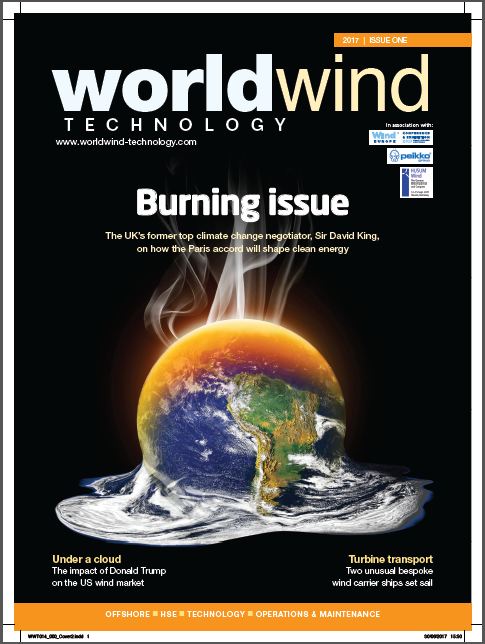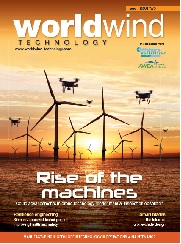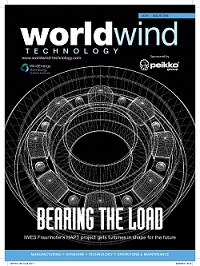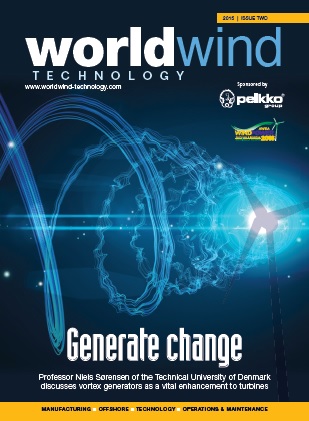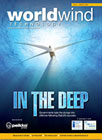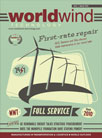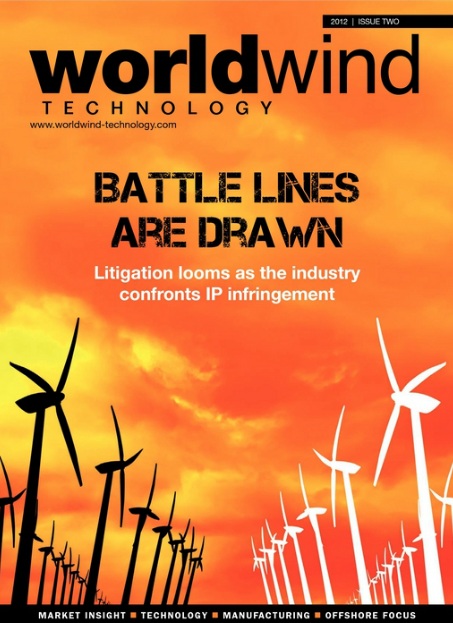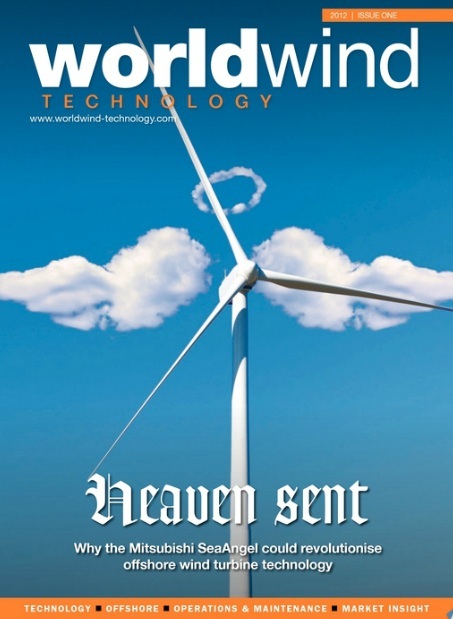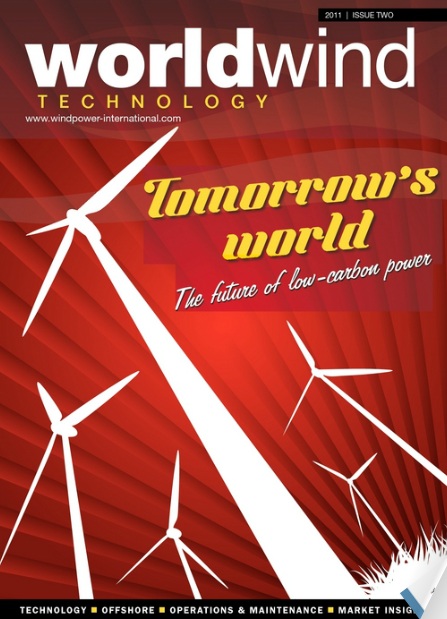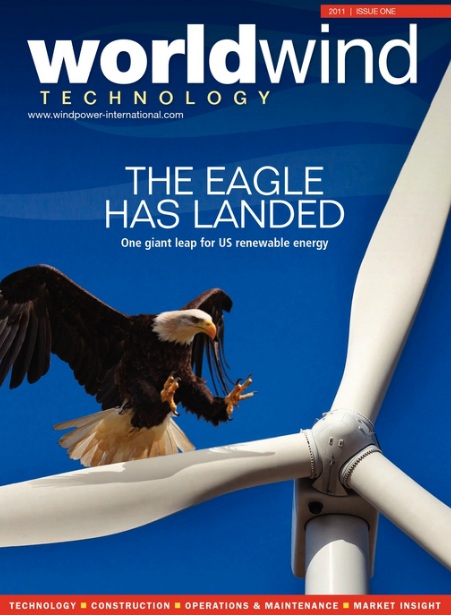The Publication
World Wind Technology Issue One 2020
We hear from Challenergy engineer Nicolas Denis about the startup's pioneering typhoon-proof turbine, and learn more about the future of offshore wind in the stormy waters of Southeast Asia.
Dr Howard Rosenbaum of the Wildlife Conservation Society and Sophie Hartfield of Ørsted talk to Greg Noone about the measures taken to protect whales and other marine mammals from wind farm construction in the North Atlantic.
While they produce green energy, turbines themselves are notoriously difficult to recycle. That, however, is about to change. Will Moffitt talks to Dr Laurence Bank at Re-wind and Richard Cochrane at Exeter University about new ways of reusing turbine propellers.
World Wind Technology Issue Two 2019
Will Moffitt talks to Stephen Bull, Equinor’s senior vice-president for wind and low-carbon development, and Marc Costa, director of the Renewables Consulting Group, about the potential it offers in the global shift to renewable energy.
Antonio de la Torre talks to Tim Gunn about the advances changing the face of the wind industry, the digital innovation under way at Siemens Gamesa and the challenges of staying cutting edge.
Also in this issue: Laura Gray explores the factors that can lead to unexpected failures in both the onshore and offshore sectors, and Grace Allen hears about the challenges in transport from Michele Mihelic, senior director of asset management and standards development at the American Wind Energy Association (AWEA).
World Wind Technology Issue One 2019
In this issue, Lightning strikes can cause huge damage to offshore turbines, particularly to blades, and are also a key safety concern for crews. Abi Millar discusses the dangers turbines face from lightning, and considers the key methods and technologies used to predict and monitor this threat with Dr Vidyadhar Peesapati of the University of Manchester.
Also, Greg Noone talks to Gabriela Molinar, a project leader of the new AI program PrognoNetz, about how the software will allow system operators to make crucial decisions without compromising Germany's wind power revolution.
Isabel Ellis speaks to Paulo Silva, senior vice-president of global blades at Senvion, and Manja Annette Behrens, who leads the Danish Technological Institute's Dreamwind project, about how turbines can be manufactured to enhance their sustainability. Plus: Taking place in Copenhagen, WindEurope Offshore 2019 expects more than 8,000 attendees from over 50 countries.
World Wind Technology Issue Two 2018
While offshore wind remains mostly a European affair, this picture is beginning to change, with ambitious installations planed across Asia. Abi Millar speaks to Feng Zhao, a Copenhagen based senior director at FTI Consulting, about what is to come.
With the opening of its new plant in Bilbao, Haizea is staking its claim to be the most significant new player manufacturing towers for wind turbines. Borja Muga, the company’s quality manager, speaks to Jim Banks about its road to attaining the highest
grade of certifications.
Also in this issue, Carmine Frisk talks to Markus Wild, the managing director of EnBW Asia-Pacific, about the company’s new ventures in Taiwan, and why the country is a fast-emerging player in the offshore wind market. And, In 2015, then UK prime minister David Cameron effectively called time on onshore wind by cutting subsidies for new projects. However, ministers have recently said they see onshore wind in the future energy mix. So which way is the wind blowing for new onshore wind farms?
World Wind Technology Issue One 2018
In this issue, As part of its ambitious carbon-reduction goals, New York State is aiming for 2.4GW of offshore wind by 2030. Following the release of a master plan that provides a roadmap for the years ahead, we ask what meeting this target would entail.
Wind is becoming a fundamental part of the power networks of many countries. As Steve Sawyer of the Global Wind Energy Council explains, the challenge now is to ensure that it works in tandem with, rather than as an alternative to, other technology, such as solar power and storage.
Plus, GlobalData shares its latest research on the wind energy market in Canada and predicts how power generation will shape up between now and 2025. And: Abi MIllar talks to Sarah Bray from Clean Line Energy Partners – one of the companies attempting to distribute energy from windy US regions to areas of high demand.
World Wind Technology Issue Two 2017
Digital transformation is big news at Engie, the French energy giant of which the interests run from natural gas and wind to solar and nuclear. Between 2016 and 2019, it will spend €1.5 billion on more than 30 digital projects, but it is renewables where previous investments are already bearing fruit, as Damien Terrié, head of Engie’s Darwin project, tells James Lawson.
As the pace of renewable energy application hastens, so too does the drive to attract a skilled workforce, resulting in a global push to skill and upskill. Andrew Tunnicliffe speaks with Carmen Maria Alfonso Sanchez, senior manager, global training & development, at LM Wind Power.
Also, Europe continues to blow away the competition when it comes to offshore wind development, with the Baltic region in particular enjoying a mini-boom, spurred on by WindEurope’s Baltic Sea Task Force. However, challenges remain in terms of regulation, adoption and grid investment. Plus, Andrew Tunnicliffe speaks with Kate Harvey, general manager of the G+ Global Offshore Wind Health and Safety Organisation, about its work to improve safety in the offshore wind farm environment, how the challenges have evolved and how they are.
World Wind Technology Issue One 2017
For 17 years, Sir David King was the UK's top climate change negotiator and adviser. In a rare interview, he tells Rumyana Vakarelska about the challenges facing the country in its push to increase clean energy.
Renewable energy now makes up an increasing proportion of national electricity grids across the world. But any people still have questions about the role of wind power. Michael Goggin, senior director of research at the American Wind Energy Association, explains how wind energy plays its part.
Also in this issue: World Wind Technology looks at the US wind power market; Dr John Coultate from Romax Insight, Paul Baker at AeroTorque and Stefan Bill of REWITEC explain how new technology can forestall expensive gearbox failures, and Jacques de Parscau, project engineer at DNV GL Energy, discusses worker safety.
World Wind Technology Issue Two 2016
As wind turbines increase in complexity and size, and manual inspection of turbines becomes less viable, industry professionals are looking to unmanned aerial vehicles, more commonly known as drones, for a solution. World Wind Technology investigates the potential that this technology has and its place in the industry's future.
With the British Government dragging its feet on the UK's renewables policies and the future of Hinkley Point C looking uncertain, it seems unlikely that the UK will meet its renewable energy output and climate change targets. In the context of ever increasing energy consumption combined with the need to fulfil commitments to reduce carbon emissions, what place does wind power have in the UK?
Also in this issue: JP Conkwright, director of quality and environmental protection, health management and safety at Siemens, explains how their H&S training techniques alleviate the risks faced by employees in the wind industry. Plus, Steve Sawyer, secretary-general of the Global Wind Energy Council, explores a range of possible futures for the global wind energy industry.
World Wind Technology Issue One 2016
Damage to blade bearings can have a disastrous impact on cost and operational availability, and as turbines grow larger, it is essential that the causes of damage be better understood. In this edition of World Wind Technology, Professor Jan Wenske of IWES Fraunhofer speaks about how the pitch-bearing test project will take stress-testing to the next level.
COP21 committed the world to reductions in carbon emissions, setting ambitious targets. However, cuts to wind energy subsidies across Europe, and a changing energy landscape, raise questions about policymakers' commitment to the deal and what these cutbacks mean for the industry. Oliver Hotham speaks to Giles Dickson, CEO of EWEA, and Doug Parr, chief scientist at Greenpeace, about the state of European wind energy.
In this issue: Tom Kiernan, 7CEO of American Wind Energy Association, writes about the country's growing use of alternative energy, Christian Vogl, project manager for rotor blades at Nordex, discusses the versatility of carbon, and Jonathan Gaventa of E3G and Anders Stouge of the Danish Energy Association discuss how a North Sea cross-border grid could lower the price of electricity.
World Wind Technology Issue Two 2015
Vortex generators are perceived across the wind energy sector as vital enhancements to turbine blades. Greg Noone talks to Professor Niels Sørensen, of the Technical University of Denmark, about the advantages and limitations of the technology.
Accurate meteorological information can help wind farm operators to plan maintenance and provide warnings for when to shut down turbines for protection. Gamesa services marketing director Christian Jourdain explains the benefits of the MEGA Meteo system.
Also in this issue: Elly Earls finds out from DONG Energy's North American general manager, Thomas Brostrøm, how its experience in European waters will prove invaluable across the pond and we find out from Christian Jourdain of Spanish wind turbine manufacturer Gamesa about the company's approach to getting the most out of early turbine models.
World Wind Technology Issue One 2015
For as long as wind farms have been built close to communities, concerns have been raised about the noise pollution they produce, making research into mitigation technologies vital for the industry. In this issue of World Wind Technology, Mark Brierley finds out from Stefan Oerlemans, what approach Siemens are taking to the problem.
With Hywind's evaluation phase complete, and other projects in progress across the globe, it would appear that we are becoming more receptive to the idea of deepwater offshore wind farms. But, despite tangible progress, we shouldn't expect commercialisation for a little while yet, as Trine Ingebjorg Ulla, head of business development floating wind, Statoil, tells Ross Davies.
World Wind Technology Issue Two 2014
Medium and light wind turbines are evolving, with Gamesa's new G114 recently setting a new record for the industry's lowest specific power rating. World Wind Technology's Jack Wittels speaks to product development director Antonio de la Torre Quiralte about the decision to switch to using blades made from glass fibre, and where low-wind-speed turbines will go from here.
Wind energy is now an attractive source of power and is delivering numerous economic benefits in the US. AWEA's Carl Levesque reveals how it is poised to play a key role in meeting the nation's future needs for clean, affordable energy.
Also in this issue: GlobalData analyses the latest leaps forward in foundation technology and considers how to address potentially critical design flaws in existing sites; Dr Povl Brondsted of the Technical University of Denmark explains what substances and techniques can be used to achieve more power at less cost; and World Wind Technology asks Dalen Copeland of EDF Renewable Services about the evolution of O&M services and the advantages of being an independent service provider.
World Wind Technology Issue One 2014
Oil pipeline explosions, earthquakes triggering nuclear meltdown and dangerous gas leaks - when it comes to accidents, the wind industry may not make the headlines in quite the same way as other parts of the energy sector, but it is certainly not accident-immune. In this issue of World Wind Technology, the European Wind Energy Association (EWEA) explains what the industry should do, and is doing, to counter the risks.
Evidence of how the wind behaves in complex situations offshore and how this affects energy yields is essential to encourage investment in the construction phase of wind farms in the UK, as Elly Earls finds out from Breanne Gellatly of the Offshore Wind Accelerator.
Following a record 2013, Brazilian wind power is looking forward to another strong year at public energy auctions thanks to its rising price per MW/h, and gradual improvements in supply and transmission. But, as Bob Moser writes, the sector still has issues that it must resolve.
And with three projects expected to begin construction over the next 18 months, the long-awaited birth of the US offshore wind sector is almost upon us, but how ready is the nation to support this fledgling industry? Jack Wittels speaks with Kevin Pearce of Arcadia Windpower and Chris Elkinton of DNV GL about the country's infrastructure and lessons to be learnt from Europe.
World Wind Technology Issue Two 2013
An effective inspection, maintenance and repair regime for wind turbine blades is crucial to the efficient operation of wind farms, but given the often harsh conditions in which installations are located - both on and offshore - in-situ blade repair is no easy feat. Mark Brierley speaks to Chris Smith of wind farm operator RES, turbine manufacturer Siemens' Thomas Schlenzig, and Charles Awbery-Maskel of chemicals manufacturer and blade repair expert Sika.
Engineering giants Siemens, Samsung and Mitsubishi have all shown interest in the UK's offshore wind sector, but, a result of the UK Government's mixed messages regarding the future of offshore wind, none has yet made a concrete investment. Elly Earls meets RenewableUK's Nick Medic to find out why this will only happen if the UK Government sets concrete, long-term targets.
Whether it's subsidies, environmental legislation or supply-chain development, future trust in the US and UK wind sectors -crucial to attracting investment - rests on striking the right balance between numerous factors. Dr Gordon Edge of RenewableUK and the American Wind Energy Association's Paul Holshouser explore the impact of the latest policies upon market confidence.
World Wind Technology Issue One 2013 (offshore special)
Europe has long been a world leader in offshore wind technology, having over 90% of the global installed capacity. In this issue of World Wind Technology, James Lawson finds out what steps are being taken in other countries to try and emulate European success, which wouldn't have been possible without the generous government subsidies that have been in place over the past decade. However, recent policy uncertainty in the US and Europe has had big consequences for the wind market. Philip Kleinfeld asks how dependent the industry is on public finance mechanisms and will it ever stand on its own legs?
Elsewhere, Abi Millar looks beyond the role of government in the growth of wind power, to private enterprise. With environmental targets looming large, big business is redoubling its efforts to become carbon neutral. But as international organisations focus on 'greening the grid', how great a role will they play in future wind investments?
World Wind Technology Issue Two 2012
With fierce competition among wind turbine manufacturers growing, patent infringement is sending companies rushing to protect their intellectual property. In this issue of World Wind Technology, Abi Miller speaks to Philip Totaro about this growing trend. Elly Earls speaks to Birgit Wieland of the German Aerospace Centre (DLR) to find out what the industry can learn from the aerospace sector. Jean Huby, CEO of Areva Wind, also explains the technological and operational challenges of moving wind farms into deeper offshore waters. Finally, Sarah Blackman asks if today's undergraduates will be suitably skilled for tomorrow's wind industry.
World Wind Technology Issue One 2012
This issue features the building of the world's largest wind turbine to date - the new SeaAngel. Mitsubushi Heavy Industry tells why the project looks set to redefine offshore power generation. Elsewhere in the magazine, Bob Moser reports on how National development bank BNDES is driving Brazil's wind power revolution, and Mike Woebbeking of Germanischer Lloyd discusses blade design and manufacturing standards. We also gain some insight from Vestas Wind Systems' Kim Bredo Rahbek on the challenge of transporting larger wind turbines.
World Wind Technology Issue Two 2011
Low-carbon power generation gets a boost with more than 40GW of new, clean power being delivered in 2011, creating thousands of jobs around the world. In this issue of World Wind Technology, Siemens gives us an insight into its comprehensive safety procedures on turbines, and Winergy tells us why, with many turbines abandoning the gearbox, it is sticking with what it knows best. The world's largest offshore wind farm, The London Array, will start up in 2012; we hear from its operator DONG.
World Wind Technology Issue One 2011
Wind power in the US has the potential to have a defining impact on the country's energy future. AWEA's Anyah Dembling assesses the impact that it is having on the US energy market, and shares her thoughts with us. Elsewhere, Morten Bülow of Vestas explains why preventative maintenance is crucial for the efficiency of wind turbines and Uwe Hinz reveals the benefits of Goldwind's permanent magnetic direct-drive system.



